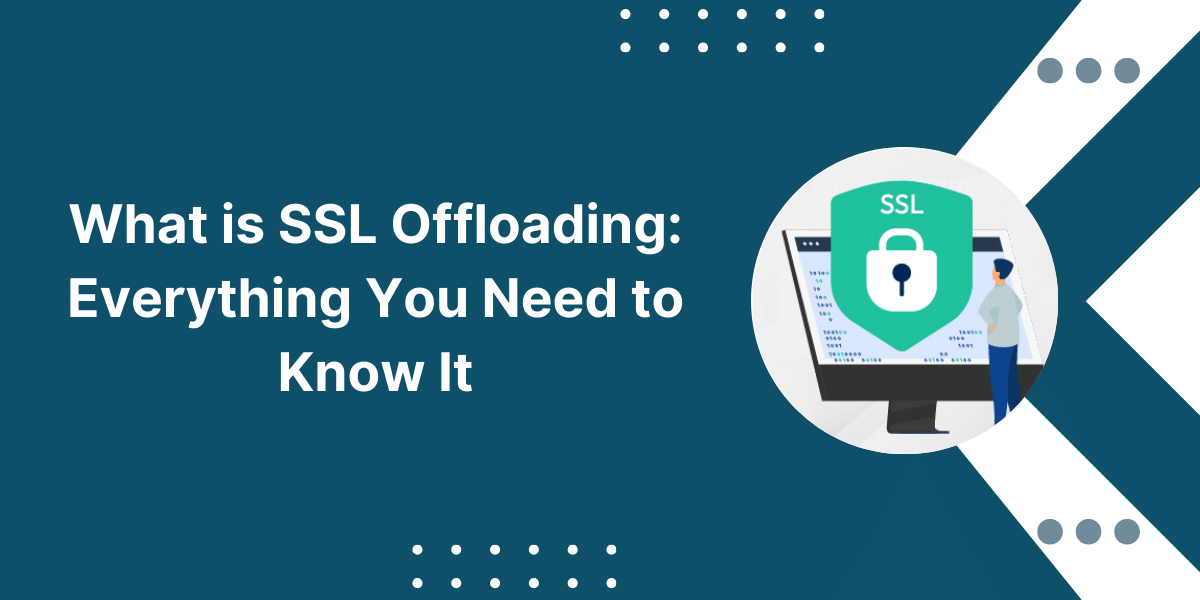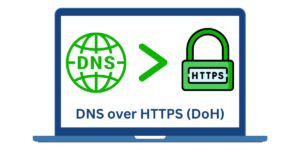Getting Started with TLS/SSL Offloading
Secure Sockets Layer (SSL) offloading, also known as TLS offloading, refers to the practice of offloading processor-intensive public key encryption from a web server to a hardware accelerator or a separate server.
SSL offloading improves website performance by freeing up the web server to focus on serving content instead of performing encryption and decryption. It also enhances security by centralizing SSL processing in dedicated hardware or servers.
This comprehensive guide provides an overview of SSL offloading, its benefits, how it works, use cases, and best practices for implementation.
What is SSL/TLS Encryption?
Before diving into SSL offloading, it helps to understand what SSL/TLS encryption is and why it’s important.
SSL (Secure Sockets Layer) and its successor TLS (Transport Layer Security) are cryptographic protocols that provide encrypted communication between a client and server. This protects sensitive information like passwords, financial data, and personal details from being intercepted by cybercriminals.
How SSL/TLS Encryption Works
- The server has an SSL/TLS certificate installed that contains the server’s public key as well as its domain name, issuing Certificate Authority, validity dates, and other details.
- When a client initiates a connection to the server, the server presents its SSL certificate to prove its identity.
- The client verifies that the certificate is valid and issued by a trusted Certificate Authority. This prevents man-in-the-middle attacks.
- Client and server negotiate a symmetric session key using public-key cryptography. This session key is used to encrypt communications for the remainder of the session.
- All data transmitted between client and server is encrypted using the session key. This prevents snooping and tampering.
- The SSL/TLS handshake happens at the start of every new session (like when you navigate to a new webpage). The encryption keys change each time to enhance security.
SSL/TLS encryption protects data in transit between clients and servers. It provides confidentiality, integrity, and authentication for applications like web browsing, email, instant messaging, and voice over IP (VoIP).
Why is SSL Offloading Needed?
SSL encryption provides robust security, but it’s computationally intensive due to the complex public key cryptography involved. SSL handshake, encryption, and decryption put a heavy load on servers.
Some real-world stats:
- SSL encryption can reduce a server’s capacity by as much as 50-70% depending on configuration and CPU power.
- For 2048-bit keys, SSL decryption takes about 5x more CPU power than encryption on many processors.
- Serving a simple HTML page over HTTPS requires 2-3x more CPU cycles versus serving it unencrypted over HTTP.
As web traffic and dependence on encryption continue to grow, SSL overhead becomes a scalability and performance bottleneck for servers.
Offloading the cryptographic legwork of SSL to separate hardware or servers prevents servers from getting bogged down. This is essential for modern security and compliance needs.
Benefits of SSL Offloading
Here are some of the top benefits of offloading SSL processing:
Improved Website Performance
- Accelerates SSL/TLS handshake and encryption tasks.
- Frees up servers to focus on core tasks.
- Supports faster page loads and response times.
- Enables scaling to handle more SSL connections.
Enhanced Security
- Centralizes SSL processing in dedicated hardware/servers.
- Simplifies TLS configuration hardening.
- Allows for easy TLS version control across systems.
- Terminates SSL connections outside web tier as added defense.
Server Savings
- Reduces CPU, memory, and bandwidth load on servers.
- Minimizes server upgrades required for encryption demands.
- Consolidates SSL licenses and certificates to fewer systems.
Compliance and Auditing
- Central store of certificates and keys simplifies management.
- Consistent TLS policies across all connections.
- Reporting and logging for compliance needs.
Operational Efficiency
- Decouples SSL management from web server admin.
- Simplifies certificate deployment and lifecycle management.
- Smoother TLS version upgrades and patches.
- High availability and failover capabilities.
The benefits go beyond performance too. SSL offloading is a best practice for security, compliance, and operational efficiency.
How Does SSL Offloading Work?
SSL offloading shifts the workload of encryption, decryption, and certificate processing from web servers to a dedicated device or server cluster. This allows web servers to focus resources on serving application data and logic.
There are two common forms of SSL offloading:
1. Hardware SSL Accelerators
Purpose-built hardware devices are installed alongside web servers to handle encryption demands. These come in the form of PCI cards or standalone appliances.
Popular examples include:
- F5 BIG-IP Local Traffic Manager (LTM)
- Citrix NetScaler
- A10 Thunder Application Delivery Controller (ADC)
The hardware accelerator takes over SSL handshake, encryption/decryption, and certificate management:
2. SSL Termination Proxies
This model uses a separate server or server cluster as an SSL termination proxy in front of the web servers:
The proxy accepts SSL connections from clients then decrypts and forwards unencrypted traffic to web servers over the backend. It encrypts server responses before sending them back to clients.
Some examples of SSL termination proxies:
The proxy offloads all SSL overhead and acts as the central endpoint for encrypted sessions. The internal network can remain unencrypted or utilize a different encryption scheme.
Common Use Cases for SSL Offloading
SSL offloading is useful for a range of technologies and deployment architectures:
Web Servers
Offloading allows web servers like NGINX, Apache, and IIS to handle more traffic while using fewer server resources per SSL connection.
Load Balancers
Pairing SSL offloading with load balancers enhances performance for traffic management. Load balancers like HAProxy and NGINX can act as SSL termination proxies.
Content Delivery Networks
CDNs reduce latency and bandwidth costs by caching and distributing content globally. SSL offloading helps CDNs handle encryption efficiently across nodes.
Cloud Environments
For IaaS environments like AWS and Azure, SSL offloading maximizes utilization of elastic compute resources.
Containerized Apps
Orchestrators like Kubernetes can leverage centralized SSL offloading to avoid configuring individual containers.
Microservices and Serverless
Delegating SSL overhead optimizes these distributed architectures for scale while minimizing re-encryption.
VoIP/Unified Communications
Offloading processor-intensive VoIP/UC traffic like SIP trunks and WebRTC helps deliver real-time performance.
Any application facing significant SSL traffic can benefit from offloading encryption work.
Best Practices for Implementing SSL Offloading
Here are some best practices to follow when implementing SSL offloading:
Choose Dedicated Hardware or Servers
Select appliances or servers that specialize in SSL processing. For example, advanced ADC appliances like F5 BIG-IP offer specialized ASIC chips to accelerate cryptographic functions.
Use Layer 7 Visibility and Control
Deploy intelligent L7 ADCs or proxies to enable full insight and fine-grained control over SSL traffic. This improves troubleshooting and security.
Maintain SSL End-to-End When Needed
Some traffic may warrant keeping SSL encryption end-to-end. Identify use cases like banking sites where re-encryption is preferred.
Limit Internal Traffic in Clear Text
Where possible, avoid internal clear text traffic. Use application layer encryption or private network segments for backend connections.
Centralize SSL Certificate Management
Store certificates in the offloading device or proxy to simplify deployment and renewal. Automate with tools like Let’s Encrypt.
Set Consistent TLS Configuration
Enforce uniform TLS cipher suites, protocol versions, and HTTP header settings on the SSL offloader to standardize connections.
Tune Offloading for High Performance
Optimize TCP profiles, caching, and SSL session reuse. Use hardware acceleration when possible. Evaluate under real-world load.
Offload New Connections Only
For client-server connections requiring end-to-end SSL, the offloader should only decrypt the initial handshake then pass through subsequent packets.
Scale Offloading Capacity
Horizontally scale offloaders and use load balancing to meet demands. monopolist vendor lock-in.
Proper planning and testing helps realize the full benefits of offloading for infrastructure resiliency
Potential Drawbacks of SSL Offloading
While SSL offloading improves efficiency, some drawbacks should be considered:
- Introduces potential single point of failure without high availability.
- Traffic in clear text on backend requires additional security controls.
- Can complicate SSL troubleshooting and certificate renewals.
- Specific hardware or software can lead to vendor lock-in.
- Additional costs for hardware or server resources.
- Latency overhead if not properly optimized.
- Re-encryption may be needed for end-to-end security.
Drawbacks are mainly tied to improper implementation. With good design and testing, these risks can be minimized.
SSL Offloading – Final Considerations
SSL offloading has become a staple optimization for modern web architectures. It bridges the gap between security and performance.
Done right, offloading enables web infrastructure to keep pace with relentless traffic growth driven by trends like encryption everywhere, Internet-of-Things, mobile access, and cloud adoption.
Organizations should evaluate their infrastructure requirements and use cases to determine where SSL offloading can help overcome bottlenecks. With encryption demands continuing to rise, offloading will only grow as a critical tool for building fast, secure, and scalable application delivery networks.
Frequently Asked Questions About SSL Offloading
What are the main benefits of SSL offloading?
The main benefits of SSL offloading include improved website performance, enhanced security, server savings, compliance and auditing, and operational efficiency. Offloading allows web servers to focus resources on serving content instead of encryption. It also centralizes SSL management for easier security and scalability.
Does SSL offloading reduce security?
No, properly implemented SSL offloading does not reduce security. It keeps standard encryption between clients and the offloading device. Sensitive data remains protected in transit. Additional internal safeguards can encrypt backend traffic as well. With centralized TLS policies, it can even improve consistency of encryption.
When should I avoid SSL offloading?
Avoid offloading for connections that require end-to-end encryption with no termination at intermediaries. Examples include banking sites transmitting financial data and VPN tunnels. However, selectively offloading new SSL session establishment can still optimize these use cases.
Can NGINX perform SSL offloading?
Yes, NGINX can easily perform SSL offloading when deployed as a reverse proxy in front of web servers. Enable SSL on NGINX and it will handle all encryption before passing requests to backend servers unencrypted. Additional NGINX servers can be added to scale SSL capacity.
How is SSL different from TLS?
SSL (Secure Sockets Layer) and TLS (Transport Layer Security) are essentially different versions of the same encryption protocol. TLS is the latest version succeeding SSL. They use similar technology to provide encrypted links between clients and servers.
Is specialized hardware required for SSL offloading?
No, SSL offloading can be implemented in software such as on a dedicated proxy server running NGINX or HAProxy. However, purpose-built hardware accelerators provide maximum performance by offloading compute-intensive cryptographic operations to specialized ASIC chips.
What are the risks when SSL is offloaded?
Main risks include increased dependence on the offloading device, potential for a single point of failure, and clear text traffic on backend networks. To minimize risks, use high availability configurations, tune performance for maximum throughput, secure backend connections, and maintain end-to-end encryption where needed.
Can SSL offloading be paired with CDNs?
Yes, SSL offloading complements content delivery networks very well. It allows CDN nodes to focus on caching and serving content fast without getting bogged down encrypting traffic. The CDN service can handle SSL centrally. SSL sessions can be cached on nodes for improved performance.
How does TLS termination differ from offloading?
TLS termination is essentially identical to SSL offloading – it refers to the same process of decrypting traffic on ingress to a web server environment. TLS termination proxy is another term for an SSL offloading server receiving encrypted connections.



